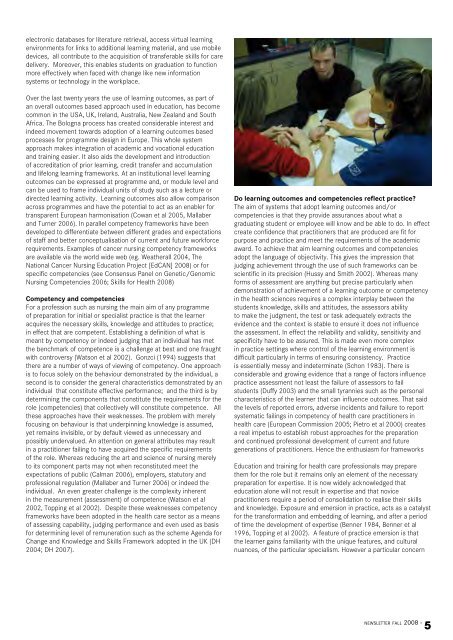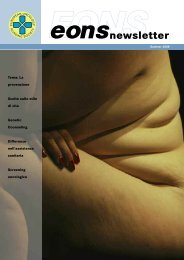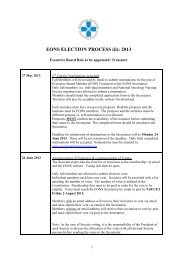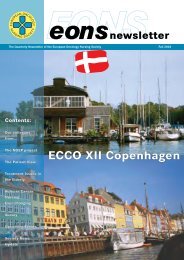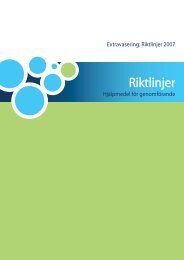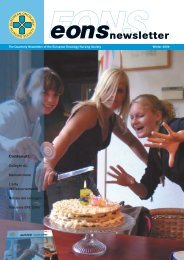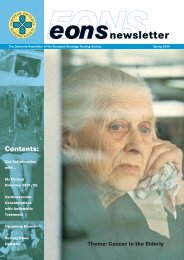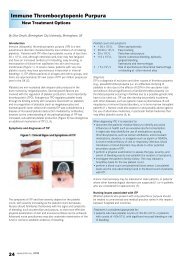English - the European Oncology Nursing Society
English - the European Oncology Nursing Society
English - the European Oncology Nursing Society
- No tags were found...
Create successful ePaper yourself
Turn your PDF publications into a flip-book with our unique Google optimized e-Paper software.
electronic databases for literature retrieval, access virtual learningenvironments for links to additional learning material, and use mobiledevices, all contribute to <strong>the</strong> acquisition of transferable skills for caredelivery. Moreover, this enables students on graduation to functionmore effectively when faced with change like new informationsystems or technology in <strong>the</strong> workplace.Over <strong>the</strong> last twenty years <strong>the</strong> use of learning outcomes, as part ofan overall outcomes based approach used in education, has becomecommon in <strong>the</strong> USA, UK, Ireland, Australia, New Zealand and SouthAfrica. The Bologna process has created considerable interest andindeed movement towards adoption of a learning outcomes basedprocesses for programme design in Europe. This whole systemapproach makes integration of academic and vocational educationand training easier. It also aids <strong>the</strong> development and introductionof accreditation of prior learning, credit transfer and accumulationand lifelong learning frameworks. At an institutional level learningoutcomes can be expressed at programme and, or module level andcan be used to frame individual units of study such as a lecture ordirected learning activity. Learning outcomes also allow comparisonacross programmes and have <strong>the</strong> potential to act as an enabler fortransparent <strong>European</strong> harmonisation (Cowan et al 2005, Mallaberand Turner 2006). In parallel competency frameworks have beendeveloped to differentiate between different grades and expectationsof staff and better conceptualisation of current and future workforcerequirements. Examples of cancer nursing competency frameworksare available via <strong>the</strong> world wide web (eg. Wea<strong>the</strong>rall 2004, TheNational Cancer <strong>Nursing</strong> Education Project [EdCAN] 2008) or forspecific competencies (see Consensus Panel on Genetic/Genomic<strong>Nursing</strong> Competencies 2006; Skills for Health 2008)Competency and competenciesFor a profession such as nursing <strong>the</strong> main aim of any programmeof preparation for initial or specialist practice is that <strong>the</strong> learneracquires <strong>the</strong> necessary skills, knowledge and attitudes to practice;in effect that are competent. Establishing a definition of what ismeant by competency or indeed judging that an individual has met<strong>the</strong> benchmark of competence is a challenge at best and one fraughtwith controversy (Watson et al 2002). Gonzci (1994) suggests that<strong>the</strong>re are a number of ways of viewing of competency. One approachis to focus solely on <strong>the</strong> behaviour demonstrated by <strong>the</strong> individual, asecond is to consider <strong>the</strong> general characteristics demonstrated by anindividual that constitute effective performance; and <strong>the</strong> third is bydetermining <strong>the</strong> components that constitute <strong>the</strong> requirements for <strong>the</strong>role (competencies) that collectively will constitute competence. All<strong>the</strong>se approaches have <strong>the</strong>ir weaknesses. The problem with merelyfocusing on behaviour is that underpinning knowledge is assumed,yet remains invisible, or by default viewed as unnecessary andpossibly undervalued. An attention on general attributes may resultin a practitioner failing to have acquired <strong>the</strong> specific requirementsof <strong>the</strong> role. Whereas reducing <strong>the</strong> art and science of nursing merelyto its component parts may not when reconstituted meet <strong>the</strong>expectations of public (Calman 2006), employers, statutory andprofessional regulation (Mallaber and Turner 2006) or indeed <strong>the</strong>individual. An even greater challenge is <strong>the</strong> complexity inherentin <strong>the</strong> measurement (assessment) of competence (Watson et al2002, Topping et al 2002). Despite <strong>the</strong>se weaknesses competencyframeworks have been adopted in <strong>the</strong> health care sector as a meansof assessing capability, judging performance and even used as basisfor determining level of remuneration such as <strong>the</strong> scheme Agenda forChange and Knowledge and Skills Framework adopted in <strong>the</strong> UK (DH2004; DH 2007).Do learning outcomes and competencies reflect practice?The aim of systems that adopt learning outcomes and/orcompetencies is that <strong>the</strong>y provide assurances about what agraduating student or employee will know and be able to do. In effectcreate confidence that practitioners that are produced are fit forpurpose and practice and meet <strong>the</strong> requirements of <strong>the</strong> academicaward. To achieve that aim learning outcomes and competenciesadopt <strong>the</strong> language of objectivity. This gives <strong>the</strong> impression thatjudging achievement through <strong>the</strong> use of such frameworks can bescientific in its precision (Hussy and Smith 2002). Whereas manyforms of assessment are anything but precise particularly whendemonstration of achievement of a learning outcome or competencyin <strong>the</strong> health sciences requires a complex interplay between <strong>the</strong>students knowledge, skills and attitudes, <strong>the</strong> assessors abilityto make <strong>the</strong> judgment, <strong>the</strong> test or task adequately extracts <strong>the</strong>evidence and <strong>the</strong> context is stable to ensure it does not influence<strong>the</strong> assessment. In effect <strong>the</strong> reliability and validity, sensitivity andspecificity have to be assured. This is made even more complexin practice settings where control of <strong>the</strong> learning environment isdifficult particularly in terms of ensuring consistency. Practiceis essentially messy and indeterminate (Schon 1983). There isconsiderable and growing evidence that a range of factors influencepractice assessment not least <strong>the</strong> failure of assessors to failstudents (Duffy 2003) and <strong>the</strong> small tyrannies such as <strong>the</strong> personalcharacteristics of <strong>the</strong> learner that can influence outcomes. That said<strong>the</strong> levels of reported errors, adverse incidents and failure to reportsystematic failings in competency of health care practitioners inhealth care (<strong>European</strong> Commission 2005; Pietro et al 2000) createsa real impetus to establish robust approaches for <strong>the</strong> preparationand continued professional development of current and futuregenerations of practitioners. Hence <strong>the</strong> enthusiasm for frameworksEducation and training for health care professionals may prepare<strong>the</strong>m for <strong>the</strong> role but it remains only an element of <strong>the</strong> necessarypreparation for expertise. It is now widely acknowledged thateducation alone will not result in expertise and that novicepractitioners require a period of consolidation to realise <strong>the</strong>ir skillsand knowledge. Exposure and emersion in practice, acts as a catalystfor <strong>the</strong> transformation and embedding of learning, and after a periodof time <strong>the</strong> development of expertise (Benner 1984, Benner et al1996, Topping et al 2002). A feature of practice emersion is that<strong>the</strong> learner gains familiarity with <strong>the</strong> unique features, and culturalnuances, of <strong>the</strong> particular specialism. However a particular concernnewsletter fall 2008 -5


